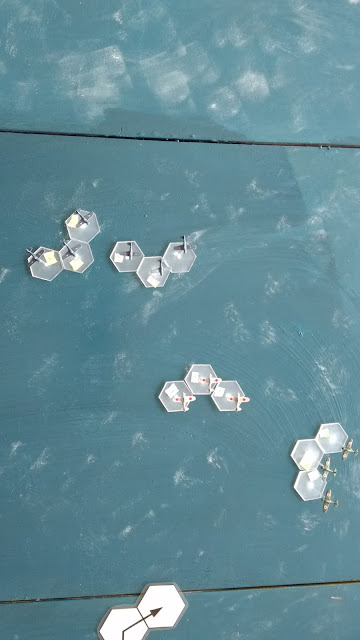I have started a new campaign, this one will be set in the Pacific and South China sea. The rules will be Harpoon 4. I may add land combat at a later date
Modern
Naval Campaign
Overview
It is 2021,
the world is has entered an economic downturn. Many major powers face
increasing unrest and political troubles at home. The US looks to a
more internal focused policy after damage from the trade war with
china took its toll. China also faces major economic problems from
the trade war and increasing isolation after the brutal subjugation
of Hong Kong.
Other
nations too have economic and political issues, but these are less
drastic. As world opinion turns on china and economic hardships
effect its people, the chines government become more bellicose. A
declaration that all ships using china's (claimed) territorial waters
must get permission, or pay a fine is the result. Many nations refuse
to do this. At first the declaration is mostly unenforced.
Near the Scarborough Shoal china has once again
banned not only fishing by Phillapine vessles but also transit and
has expanded the area where these rules apply. The recent harassment
of these vessles has caused the Philapine navy to send a vessle to
carryout a freedom of navigation mission through this claimed area.
Scarborough
Contact
2 Philippine
patrol boats, PS-28 BRP Cebu and PS-20 BRP Magat Salamat, are
conducting a freedom of navigation manoeuvrer through china's
declared exclusive zone around the Scarborough Shoal. Their
direction and location have been reported and a single Chinese Type
053 (Jianghu IV) is attempting to intercept. The Philippine air force
also has 1 KAI golden eagle on standby.
Objectives
Philippines
Strategic
Complete
freedom of navigation manoeuvrer, drive off any aggressor. Do not
loose any ships.
Tactical
Do not
loose any ships, inflict damage on any aggressor.
China
Strategic
Prevent
Enemy ships entry into security zone. Avoid damage
Tactical
Prevent
enemy ships entry into security zone, do not loose the ship.
The contact
at 3.15pm local time
The 2
Philippine ships continued on there straight course and were
intercepted by the Chinese frigate. Both had radar contact, the
Chinese ship matched the Philippine ships course at just over 6
nautical miles away and broadcast warnings. The Philippine ships
continued on their course.
At 4.06 the
Chinese ship fired a warning shot. The Philippine captains did not
react and continued.
At 4.10 the
Chinese ship open fire with its main gun. The first rounds missed and
the Philippine ships under the assumption that this was another
warning did not react. The second set of rounds struck the Magat
Salamat, the shells doing some damage to the smaller ship.
At this
point both Philippine ships turned towards the Chinese ship in order
to get into range. Over the next 2 minutes the Chinese ship continued
to fire and miss the smaller ships. At 4.14 a second round struck
the Magat Salamat and this time did significant damage taking out
the radar, main gun and rudder.
As the Magat
Salamat, now unable to manoeuvrer effectively, tries to disengage the
Cebu starts to fire its main gun. Once again both ships miss several
times.
4.17 A round
from the Cebu strikes the Beihai doing very light damage. Having
taken a hit the chinese ship responds with its missles.
4.18 1 anti
ship missile is launched towards the Cebu.
4.19 The
Cebu misses in its attempt to bring down the missile and is struck.
The small ship is knocked out of the fight and begins to sink.
4.20 The
Beihai launches a second missile towards the Magat Salamat.
4.23 The
Magat Salamat is struck and sunk by the missile.
4.31 A KIA
golden Eagle which had been prepared earlier arrives in the area. It
locates the Beihai on Radar and proceeds towards the target. At a
distance of around 10 nm it launches 2 maverick missiles. As they
approach the Beihai, 1 is shot down by the defensive anti air fire.
The second strikes the ship. The plane then launches the second set
of 2 missiles both of these make it through the AA fire and strike
the Beihai.
4.35 The
Eagle leaves the combat area having used its payload. The Beihai has
been heavily damaged but is still able to sale and makes it's way
back to port.
Result
Tactical
victory for China.
The
successful enforcement of the Security zone shows that china is not
bluffing. Also the easy destruction of 2 enemy ships demonstrates the
power of the Chinese navy. However the damage inflicted by 1 plane
shows the danger that a lack of AA or fighter support can have. The
distance from the mainland and the airbases there shows a possible
weakness. The limited modern elements of the south east Asian
countries could be a significant threat if grouped together.
Political
Results
The result
is not good for the president of the Philippines. The loss of 2 ships
(even if they were the oldest in the fleet) will not go down well
with his nationalist supporters back home. However, with this event
he has demonstrated the threat that china poses and this may help
unify the ASEAN nations at the emergency meeting soon to be held. The
fact the the US has only offered words rather than action also helps
this cause.
In China the
result is greeted with celebration by the public and repeated on the
public news broadcasters. This is what the government hoped for as
people, for a time, forget the economic troubles. The threat posed by
the ASEAN as a group has been noted though and by threats and bribes
attempts will be made to split them up. Also the US's lack of action
is encouraging. Bigger plans can now be carried out with confidence.



























































